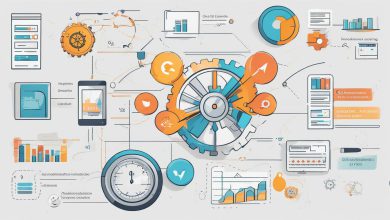
Welcome to the exciting world of app development! If you’re just starting out, there’s no need to fret. We’ll take you on a journey from the basics of Dart programming to becoming proficient in Flutter development, all while adhering to the best development practices. With the increasing popularity of Flutter programming, it’s essential to gain a strong understanding of both Dart and Flutter.
In this article, we’ll cover everything you need to know about Dart programming fundamentals to mastering advanced Flutter development techniques. You’ll also learn how to incorporate the best development practices in your app development process. By the end of this article, you’ll have the knowledge and skills necessary to create robust and efficient Flutter applications.
So, whether you’re a beginner or an experienced developer, let’s dive into the world of Dart and Flutter programming and discover how you can enhance your app development skills!
Let’s get started with the basics of Dart programming!
Understanding Dart Programming Fundamentals
If you want to become proficient in Flutter development, understanding the basics of Dart programming is key. Dart is a powerful language that allows developers to write efficient and clean code, making it an essential skill to possess.
Let’s dive into the fundamentals of Dart programming:
- Variables: In Dart, variables can be declared using the var keyword for dynamic typing or explicitly defining the data type using the type name.
- Data types: Dart supports several data types, including int, double, bool, String, and dynamic. Understanding each type is essential for writing effective code.
- Control flow: Conditional statements and loops are the backbone of programming. In Dart, if-else, switch-case, and loops like for and while are used to control the flow of code execution.
- Functions: In Dart, functions are first-class objects. They can be assigned to variables, passed as parameters, and returned as values. Reusable code is essential for efficient programming, and Dart makes it easy to achieve.
By mastering these fundamentals, you will have a solid foundation to write efficient and clean code, ensuring your app development skills stand out.
Mastering Flutter Development Techniques
Now that you have a solid foundation in Dart programming, it’s time to take your Flutter development skills to the next level. In this section, we will explore advanced techniques and best practices that will help you build complex and feature-rich Flutter applications.
One of the key aspects of Flutter programming is widget composition. Widgets are the building blocks of a Flutter application and understanding how to compose them effectively is crucial for creating a well-designed and maintainable codebase. By breaking down complex user interfaces into smaller, reusable widgets, you can simplify your code and make it more modular.
Another important topic in advanced Flutter development is state management. As your application grows in complexity, managing different states becomes more challenging. It’s important to understand various approaches to state management and choose the one that best fits your project’s requirements.
Navigation is another critical aspect of app development. Flutter offers a wide range of navigation options, including basic routing and more complex navigation solutions. Understanding the different types of navigation and how to implement them effectively will help you create a seamless user experience for your app.
Finally, working with external APIs is a common requirement in many Flutter applications. In this section, we will explore how to work with APIs in Flutter, including making HTTP requests and parsing JSON responses.
By mastering these advanced Flutter techniques, you will be able to build robust and efficient applications that provide a great user experience. Stay tuned for the next section, where we will discuss best development practices in Flutter.
Adhering to Best Development Practices in Flutter
Flutter programming allows developers to create visually appealing and feature-rich applications. However, writing efficient and maintainable code is equally important. Adhering to best development practices is crucial to ensure that your codebase is scalable and can be easily maintained.
Code Readability
Readable code is essential for maintainability. By using appropriate variable names and comments, you can help other developers understand your code. It is also important to follow a consistent coding style throughout your project. This will make your codebase easier to navigate and modify.
Scalability
As your project grows, it is important to make sure that your code can handle the additional complexity. Modularizing your codebase into smaller parts and separating concerns will make it more scalable. Using design patterns such as MVC or MVVM can also help with this.
Performance Optimization
Optimizing performance is crucial for a smooth user experience. Avoiding unnecessary computations and minimizing the use of memory-intensive operations can help improve performance. Flutter also provides tools such as the Performance Overlay that can assist with identifying performance bottlenecks.
Maintainability
Maintaining your codebase over time can be challenging. However, by adhering to best development practices such as using a version control system and writing clean code, you can make the process easier. Doing regular code reviews and unit testing can also help catch errors early and improve maintainability.
By following these development practices, you can ensure that your Flutter projects are efficient, maintainable and scalable. Remember to always strive for continuous improvement and stay up to date with the latest development practices.
Conclusion
Congratulations on embarking on the journey from Dart Basics to Flutter Proficiency! By adhering to best development practices, you now have the knowledge and skills to create robust and efficient Flutter applications. Remember to continuously improve your skills and stay updated with the latest advancements in Dart and Flutter to stay at the forefront of app development.
Always keep in mind the importance of code readability, scalability, performance optimization, and maintainability when developing in Flutter. These best practices will help you create high-quality code that is easier to maintain, debug, and enhance.
Thank you for joining us on this journey. We hope that by exploring Dart programming fundamentals and mastering advanced Flutter techniques, you will be able to take your app development skills to the next level. Continue to prioritize best development practices and strive for Flutter proficiency, and the possibilities for your app development endeavors are endless.






